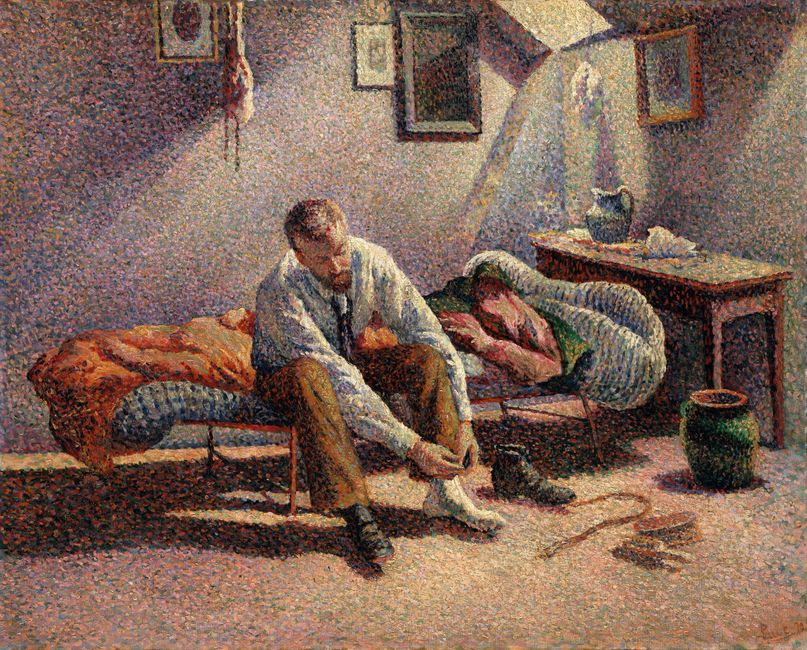
Morning Interior
Maximilian Luce, Morning Interior, 1890.
The original was created using oil on canvas.
Born in Paris in 1858, Maximilian Luce was a French Neo-impressionist artist, known for his paintings, illustrations, engravings, and graphic art, and also for his anarchist activism. Beginning his career as an engraver, he eventually focused on painting, first as an Impressionist, then as a Neo-impressionist, and finally returning to Impressionism. Though not as well-known as fellow Pointillists, Seurat or Signac, Luce created an impressive body of work that exhibited the social conscious which weaved art, science, and politics together in nineteenth century France.
Moring Interior is painted in a technique known as pointillism – meaning tiny dots of paint placed side-by-side and not mixed. As color theory was being widely studied at this time, artists learned that, at a certain distance, your eyes will meld the colors together thus creating the subtle rich colors you see here.
In his genre scene Morning Interior, Luce very intimately portrays his close friend and fellow painter Gustave Perrot getting dressed as the morning light shines down through two skylights above. The artist and his stark living quarters are painted with vivid, quickly applied dots of bright red, orange, yellow and blue, and the soft light conveys a sense of delicacy.Luce’s technical execution of the human form stood out amongst other Neo-Impressionist’s work and suggests the importance he placed on expressing the thoughts, vocation, and the complexities of the figure.
Throughout his career, Luce was interested in the theme of the working man, and often painted the daily life of fellow artists. Here, viewers are invited in to witness Perrot’s morning routine. The narrative then reflects the importance and sentiment Luce held for the working artist and their contributions to Parisian culture. By visually portraying middle-class society, he was able to explore artists at a time when their personal and work lives changed significantly.
Much of nineteenth century French art portrayed the changing times through a new lens of political, social, and creative ideals. With the onset of Industrialism, manufactured goods took jobs away from artisans. Luce specifically chose this subject matter to address this issue and the growing division between the classes. By doing so, he artfully declares that artists and artisans are important enough not only to adorn his own canvas, but also the art community in its entirety.
Fun pointillism activity for kids:
https://www.easypeasyandfun.com/georges-seurat-pointillism-art-lesson-for-kids/
*genre scene – A type of painting that depicts scenes of everyday life.
impressionism – Beginning in 1872 with Monet’s painting Impression: Sunrise, and through to around 1900, the Impressionists created works that aimed to capture the visual impression made by a scene. The Impressionist artists pursued their own personal directions in theme, technique, and style, but shared the impressionist palette, came under the influence of Japanese prints, and were effected by the camera and photography. The use of bright, fragmented, pure color and a preoccupation with the effects of light were among the hallmarks of Impressionism.
*neo-impressionism – is a term coined by French art critic Félix Fénéon in 1886 to describe an art movement founded by Georges Seurat. Seurat’s most renowned masterpiece, A Sunday Afternoon on the Island of La Grande Jatte, marked the beginning of this movement when it first made its appearance at an exhibition of the Salon des Indépendant) in Paris. Around this time, the peak of France’s modern era emerged, and many painters were in search of new artistic methods. Followers of Neo-Impressionism, in particular, were drawn to modern urban scenes as well as landscapes and seashores. Science-based interpretation of lines and colors influenced Neo-Impressionists’ characterization of their own contemporary art.
The pointillist (divisionist) technique is often mentioned in this context, because it was the dominant technique in the beginning of the Neo-impressionist movement.
Some argue that Neo-Impressionism became the first true avant-garde movement in painting. The Neo-Impressionists were able to create a movement very quickly in the 19th century, partially due to its strong connection to anarchism, which set a pace for later artistic manifestations. The movement and the style were an attempt to drive “harmonious” vision from modern science, anarchist theory, and late 19th-century debate around the value of academic art. The artists of the movement “promised to employ optical and psycho-biological theories in pursuit of a grand synthesis of the ideal and the real, the fugitive and the essential, science and temperament.”
*pointillism – (divisionism) In painting, a systematic use of optical mixtures. Instead of mixing pigments on the palette, the artist applied pure colors, in small dots or dashes; seen at the right distance, the fragmented areas of vivid color dots produced the effect of color areas more subtle and rich than could be achieved by conventional techniques.
Maximilian Luce
Copyright © 2020 Emergency Art Museum - All Rights Reserved.
*The Emergency Art Museum claims no ownership, or copyright to any materials found here, or on-site. The Emergency Art Museum functions solely as a non-commercial, non-profit, educational resource for the community. All artwork represented or reproduced, has been done so for educational purposes only under the fair use act.
-Johnny DePalma, Owner / Curator
-Janelle Graves, Art Historian / Museum Educator